Tanks
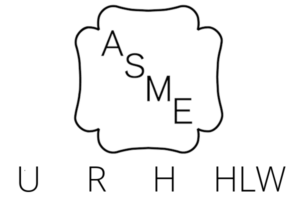 We build tanks – alloy stainless steel or carbon steel, vertical or horizontal, lined or unlined, insulated or not, and as standard units or custom. We have over 100 years of experience manufacturing tanks, and our capabilities extend to virtually any size tank, and any customizations for pressure, temperature, or other specifications.
We build tanks – alloy stainless steel or carbon steel, vertical or horizontal, lined or unlined, insulated or not, and as standard units or custom. We have over 100 years of experience manufacturing tanks, and our capabilities extend to virtually any size tank, and any customizations for pressure, temperature, or other specifications.
Some of the different types of ASME code tanks we build include:
Thermal Energy Storage Tanks (TES)
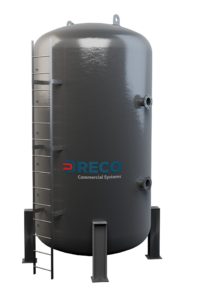
RECO Commercial Systems’ thermal energy storage tanks are used forstoring thermal energy in chilled water district cooling systems. TES tanks take advantage of off‐peak energy rates by cooling water during
these hours (usually overnight) and using it during high‐rate hours
(usually daytime).
RECO Commercial Systems’ thermal energy storage tanks can be engineered to meet various heating or cooling requirements. Our engineering team employs computational fluid dynamic (CFD) analysis to simulate fluid and heat flow to optimize the physical design of the vessel (including internal baffles, diffusers and manifolds) to ensure fluid stratification will meet system requirements.
ASME Code Pressure Vessels
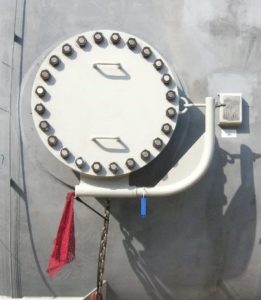 Industrial and commercial operations use ASME code pressure vessels for storage, blending, mixing, and dispensing. Our team will work with you to build a tank that meets your team’s needs, no matter how challenging or unique.
Industrial and commercial operations use ASME code pressure vessels for storage, blending, mixing, and dispensing. Our team will work with you to build a tank that meets your team’s needs, no matter how challenging or unique.
We are an ASME code facility with ‘U’, “R”, “H” and “HLW” stamp certifications that is backed by a robust quality control program and a technical staff with over 130 years of combined experience. Our design experience with process tanks goes back over a century, and we routinely provide such options and designs as:
API Tanks
Our experience with API tanks includes building in accordance with API 620, API 650 and API 653. We have built these with flat bottoms, sloped bottoms, cone roofs, hoppers, and many designs of platforms, ladders and handrails – with or without mounting skids or external piping and components.
Filter Vessel Tanks
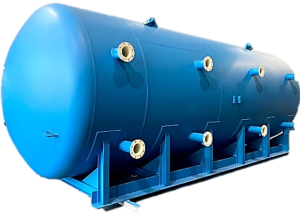 We are one of the largest and most trusted suppliers of filter vessel tanks in the US. We supply many of the major filtration OEM’s for their pressure filtration systems. This may include, not only the pressure containing vessel, but also internal piping manifolds, ladders, platforms, custom supports, custom manways, and external piping. Our reputation for quality, timeliness, and reliability are what gives us our strong presence in this market.
We are one of the largest and most trusted suppliers of filter vessel tanks in the US. We supply many of the major filtration OEM’s for their pressure filtration systems. This may include, not only the pressure containing vessel, but also internal piping manifolds, ladders, platforms, custom supports, custom manways, and external piping. Our reputation for quality, timeliness, and reliability are what gives us our strong presence in this market.
Blowdown and Flash Tanks
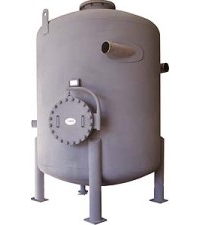 Blowdown tanks are another type of process tank we build. Manufactured to ASME Section VIII, Div. 1 standards, a blowdown tank receives hot water or steam from a boiler during a blowdown operation. Once this fluid is in the tank, it is held until the pressure and temperature fall to a low enough energy state that it is safe to be sent downstream (usually a sanitary sewer).
Blowdown tanks are another type of process tank we build. Manufactured to ASME Section VIII, Div. 1 standards, a blowdown tank receives hot water or steam from a boiler during a blowdown operation. Once this fluid is in the tank, it is held until the pressure and temperature fall to a low enough energy state that it is safe to be sent downstream (usually a sanitary sewer).
A flash tank operates in a similar way, serving as a collection point for one or more condensate drain lines. The flash tank receives high pressure condensate, which when exposed to the lower pressure in the tank, will “flash” (i.e., rapidly vaporize) back to steam, but at the lower pressure. This low-pressure steam is then recycled to devices, such as our HX2 series steam-to-water heaters.
